Articles
- Page Path
- HOME > J Korean Acad Nurs > Volume 39(6); 2009 > Article
-
Original Article
- Effects of Music Therapy and Rhythmic Exercise on Quality of Life, Blood Pressure and Upper Extremity Muscle Strength in Institution-Dwelling Elderly Women
- Eun Young Jeon, Sook Young Kim, Hyun Suk Yoo
-
Journal of Korean Academy of Nursing 2009;39(6):829-839.
DOI: https://doi.org/10.4040/jkan.2009.39.6.829
Published online: December 31, 2009
1Associate Professor, Department of Nursing, Daegu Haany University, Daegu, Korea.
2Associate Professor, Department of Nursing, College of Health Science, CHA University, Pocheon, Korea.
3Visiting Professor, Department of Welfare for the Elderly, Daegu Haany University, Daegu, Korea.
- Address reprint requests to: Kim, Sook Young. Department of Nursing, College of Health Science, CHA University, 198-1 Donggyo-dong, Pocheon 487-010, Korea. Tel: 82-31-725-8318, Fax: 82-31-725-8329, kimsy@cha.ac.kr
Copyright © 2009 Korean Society of Nursing Science
Abstract
-
Purpose
- The purpose of this study was to determine the effects of music therapy and rhythmic exercise on health related quality of life, blood pressure and upper extremity muscle strength in the institution-dwelling elderly women.
-
Methods
- The study was designed using a nonequivalent control group pretest-posttest design. The participants consisted of 35 elders (18 in the experimental group and 17 in the control group). The music therapy and rhythmic exercise were developed by the investigators. The experimental group took part in this program twice a week for 8 weeks. The Short Form 36 health survey questionnaire, blood pressure and grasp power scale were used as instruments. The data were analyzed using SPSS 14.0.
-
Results
- Repeated measures ANOVA revealed that music therapy and rhythmic exercise had positive effects on quality of life, especially on vitality, general health and mental health. Also, there were statistically significant differences in diastolic blood pressure and upper extremity muscle strength between the pretest and posttest in the experimental group.
-
Conclusion
- The study suggests that this program can be applied for older women in long-term facilities to improve quality of life, blood pressure and upper extremity muscle strength.
- 1. What is music therapy? American Music Therapy Association. 2005;03 07 Retrieved July 7, 2009. from http://www.musictherapy.org/faqs.html.
- 2. Choi JH, Kwon BY, Lee GM. Physical dimensions of aging. 2000;Seoul, Jungdam.
- 3. Chung MS. Quality of life in the elderly living in the community and in institutions. The Korean Journal of Development Psychology. 2007;20:145–169.
- 4. Cohen J. Statistical power analysis for the behavioral sciences. 1988;Hillsdale, NJ, Lawrence Erlbaum Associates.
- 5. Cook JD. Music as an intervention in the oncology setting. Cancer Nursing. 1986;9:23–28.PubMed
- 6. Heber L. Dance movement: A therapeutic intervention for psychiatric clients. Perspectives in Psychiatric Care. 1993;29(2):22–29.PubMed
- 7. Hopkins DR, Murrah B, Hoeger WW, Rhodes RC. Effect of low-impact aerobic dance on the functional fitness of elderly women. The Gerontologist. 1990;30:189–192.ArticlePubMed
- 8. Jeon MY, Choe MA. Effect of Korean traditional dance movement on psychophysiological variables in elderly Korean women. Journal of Korean Academy of Adult Nursing. 1996;26:833–852.
- 9. Jo K, Lee HJ. Factors related to life satisfaction in young- old, old, oldest-old women. Journal of Korean Academy of Nursing. 2009;39:21–32.PubMed
- 10. Kim CK, Lee WY, Bae YJ, Kim HS. A changes of the upper and lower extremity muscle function in the elderly. Exercise Science. 2000;9:405–415.
- 11. Kim KB, Kim IS, Jeong MY, Oh HK, Kwon YS, Lee EJ, et al. The effect of the musical therapy on depression and quality of life in the institutional elderly. Journal of Korea Gerontological Nursing Society. 1999;1:213–223.
- 12. Kim SH. A meta-analysis of literature on the effects of music therapy outcome research. Korean Journal of Music Therapy. 2002;4(2):19–40.
- 13. Kim SJ, Hwang JU, Lee SH. Accuracy of the sphygmomanometer for measuring of blood pressure. Journal of Korean Academy of Family Medicine. 1997;18:1500–1507.
- 14. Koh SB, Chang SJ, Kang MG, Cha BS, Park JK. Reliability and validity on measurement instrument for health status assessment in occupational workers. Journal of Preventive Medicine and Public Health. 1997;30:251–266.
- 15. 2004 National survey of living status and welfare needs of the elderly. Korea Institute of Health and Social Affairs. 2005;02 18 Retrieved October 20, 2008. from http://www.mw.go.kr.
- 16. 2008 National survey of living status and welfare needs of the elderly. Korea Institute of Health and Social Affairs. 2009;07 13 Retrieved July 20, 2009. from http://www.mw.go.kr.
- 17. Lee SH, Kim SH, Jung MH, Kim YS. The effects of music therapy on the quality of life of stroke patient. Journal of Welfare for the Aged. 2008;41:205–234.
- 18. Lee SJ. An application effect of rhythmic movement program for the health promotion in the elderly. Journal of Korean Academy of Nursing. 2000;30:776–790.ArticlePDF
- 19. Lee WY. The effect of rhythm for life music therapy program for the health promotion in the elderly. 2003;Seoul, Chung Ang University. Unpublished doctoral dissertation.
- 20. Lim YM. Effects of movement/exercise on physical and emotional functioning in elders with cognitive impairments. Journal of the Korean Gerontological Society. 2002;21:197–211.
- 21. McCaffrey R, Freeman E. Effect of music on chronic osteoarthritis pain in older people. Journal of Advanced Nursing. 2003;44:517–524.ArticlePubMedPDF
- 22. Park MJ, Jung Y. The effect of music therapy on the elderly people's depression and life-satisfaction. Journal of Korean Academy of Community Health Nursing. 2005;16:241–248.
- 23. Shin MG, Cho WS. Human physiology. 1997;Seoul, Hyunmoonsa.
- 24. Sorrell JA, Sorrell JM. Music as a healing art for older adults. Journal of Psychosocial Nursing and Mental Health Services. 2008;46(3):21–24.Article
- 25. Sung KW. The effect of a health maintenance program on physical function and mental health of the elderly in nursing homes. Journal of Korean Academy of Nursing. 2007;37:478–489.ArticlePubMedPDF
- 26. Sung KW, Kim MH. Self-care behaviors and depressive symptoms of low-income elderly women with hypertension. Journal of Korean Academy of Nursing. 2008;38:593–602.ArticlePubMed
- 27. Ware JE, Sherbourne CD. The MOS 36-item shortform health survey (SF-36): Conceptual framework and item selection. Medical Care. 1992;30:473–483.ArticlePubMed
- 28. Yang YJ. Exercise in the elderly. Journal of the Korean Geriatrics Society. 2002;6:Suppl. 1. 317–324.
REFERENCES
Figure & Data
REFERENCES
Citations

- Effects of exercise with music in frail older adults: a systematic review and meta-analysis
Gwang Suk Kim, Namhee Kim, Min Kyung Park, Layoung Kim, Jae Jun Lee, Seungbum Yang
BMJ Open.2025; 15(4): e095602. CrossRef - Rehabilitation interventions at senior day centres for older adults: a scoping review
Marie Jönsson, Cecilia Pettersson, Mialinn Arvidsson Lindvall
Frontiers in Public Health.2025;[Epub] CrossRef - The Influence of Guozhuang Dance on the Subjective Well-Being of Older Adults: The Chain Mediating Effect of Group Identity and Self-Efficacy
Yuanzheng Lin, Bin Zhao, Xiujie Ma
International Journal of Environmental Research and Public Health.2022; 19(21): 14545. CrossRef - Music Program Development Using the Ukulele in Community-dwelling Old Adults and Its Effect
Gyeong Hye Kang, Nam Joo Je
Journal of Korean Academy of Community Health Nursing.2021; 32(2): 220. CrossRef - Effects of an Active Music Therapy Program on Functional Fitness in Community Older Adults
Shu-Ya CHAN, Chun-Fei CHEN
Journal of Nursing Research.2020; 28(5): e111. CrossRef - Joint predictability of physical activity and body weight status on health-related quality of life of patients with hypertension
Taofeek O. Awotidebe, Victor O. Adeyeye, Suraj A. Ogunyemi, Luqman A. Bisiriyu, Rufus A. Adedoyin, Michael O. Balogun, Rasaaq A. Adebayo, Omolara D. Amosun
Journal of Exercise Rehabilitation.2017; 13(5): 588. CrossRef - The Effects of Music Activity on Health Aging
HAN GA YOUNG, Kim,Young Sun, Young Sam Oh
Health and Social Welfare Review.2016; 36(3): 363. CrossRef - The effects of senior brain health exercise program on basic physical fitness, cognitive function and BDNF of elderly women - a feasibility study
Jung-Eun Byun, Eun-Bum Kang
Journal of Exercise Nutrition & Biochemistry.2016; 20(2): 8. CrossRef - Effects of Band Therapy Using Music on Grasping Power, Depression, and Personal Relationships in Nursing-Home-Dwelling Elderly Individuals
Eun Kyung Chang, Heeok Park, Miran Jung, Hae Kyeong Lee, Jieun Park, Mijung Park, Minsuk Gang
Open Journal of Nursing.2016; 06(11): 958. CrossRef - La riabilitazione motoria nel morbo di parkinson: nuovi interventi e prospettive future
Chiara Di Nuzzo
RICERCHE DI PSICOLOGIA.2015; (4): 545. CrossRef - Developing a Community Capacity Builded Exercise Maintenance Program for Frail Elderly Women
Yeon Hee Choi, Sun Yi Hong
The Korean Journal of Rehabilitation Nursing.2015; 18(2): 153. CrossRef - Effect of Music Therapy on Anxiety, Blood Pressure, Heart Rate and Glucose Levels of Patients Undergoing Surgery during Spinal Anesthesia
Gye Seon Jeong, Mi Hyung Kim
Journal of Korean Academy of Fundamentals of Nursing.2015; 22(1): 25. CrossRef - Physical rehabilitation for older people in long-term care
Tom Crocker, Anne Forster, John Young, Lesley Brown, Seline Ozer, Jane Smith, John Green, Jo Hardy, Eileen Burns, Elizabeth Glidewell, Darren C Greenwood
Cochrane Database of Systematic Reviews.2013;[Epub] CrossRef - Spiritual coping in rehabilitation–a comparative study: part 2
Donia Baldacchino, Kristina Torskenaes, Mary Kalfoss, Josette Borg, Aaron Tonna, Clifford Debattista, Neville Decelis, Rodianne Mifsud
British Journal of Nursing.2013; 22(7): 402. CrossRef - Self‐Reported Quality of Life Before and After Aerobic Exercise Training in Individuals with Hypertension: A Randomised‐Controlled Trial
Fatai A. Maruf, Aderonke O. Akinpelu, Babatunde L. Salako
Applied Psychology: Health and Well-Being.2013; 5(2): 209. CrossRef - Effects of a Cognition Activation Program for the Institutionalized Old-Old in Korea
Hung Sa Lee, Dohyun Lee
Journal of Korean Academy of Community Health Nursing.2013; 24(4): 427. CrossRef - The Effects of Exercise in the Frail Elderly
Young-Im Park, Kang-Yi Lee, Tae-Im Kim, Moung-Hee Jeon, Dong-Oak Kim, Ji-Hyun Kim
Journal of Korean Academy of Community Health Nursing.2012; 23(1): 91. CrossRef - Effects of a Recreational Combination Gymnastics Program for Old-old Women
Yeon Hee Choi, Choon Ji Lee
Journal of Korean Academy of Nursing.2012; 42(6): 843. CrossRef - The Effects of BeHaS Exercise Program on Muscle Strength and Flexibility in Institutionalized Elders
Sun-Ae Kim
Journal of muscle and joint health.2011; 18(1): 93. CrossRef - Music Therapy on Anxiety, Stress and Maternal-fetal Attachment in Pregnant Women During Transvaginal Ultrasound
Hye Sook Shin, Ju Hee Kim
Asian Nursing Research.2011; 5(1): 19. CrossRef - Development and Evaluation of Functional Group Activity Program on Institutionalized Aged
Yo-Soon Bang, Hee-Young Kim
Journal of muscle and joint health.2011; 18(1): 83. CrossRef - Effects of 16-week combined exercise on body composition, cardiovascular function, and maximal muscle strength in old-old elderly male
배지철, 김성철, Hong Kim, 김만겸
Exercise Science.2010; 19(4): 381. CrossRef
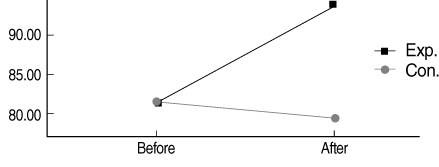
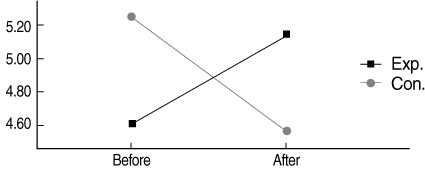
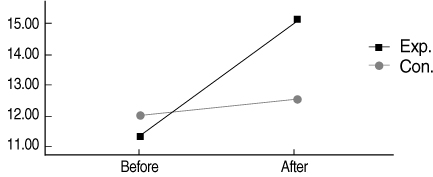
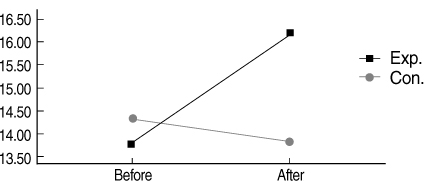
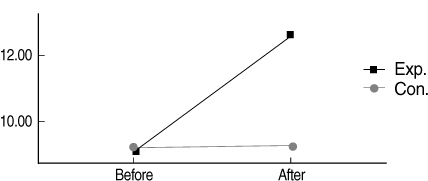
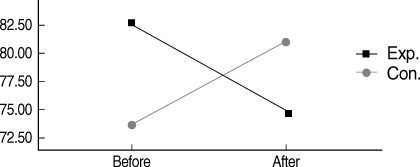
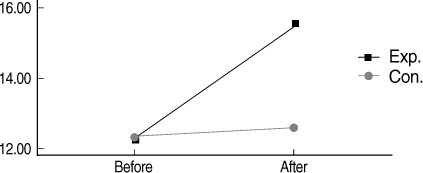
Figure 1
Figure 2
Figure 3
Figure 4
Figure 5
Figure 6
Figure 7
Music Therapy and Rhythmic Exercise Schedule
Homogeneity Test of General Characteristics between Experimental and Control Group
*Fisher's exact test.
Exp.=experimental group; Con.=control group; GDS=Geriatric Depression Scale.
Homogeneity Test of Quality of Life, Blood Pressure and Upper Extremity Muscle Strength before Intervention
Repeated Measures ANOVA in Quality of Life, Blood Pressure and Upper Extremity Muscle Strength
Exp.=experimental group; Con.=control group.
*Fisher's exact test. Exp.=experimental group; Con.=control group; GDS=Geriatric Depression Scale.
Exp.=experimental group; Con.=control group.
 KSNS
KSNS
 E-SUBMISSION
E-SUBMISSION







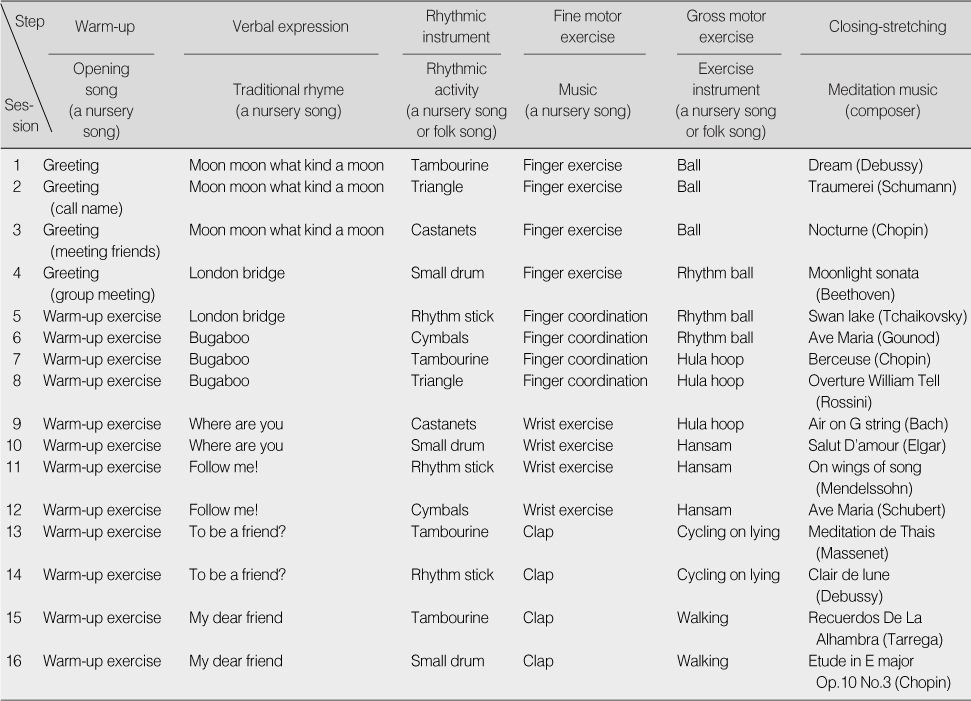
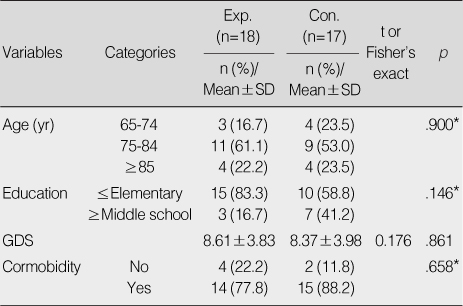
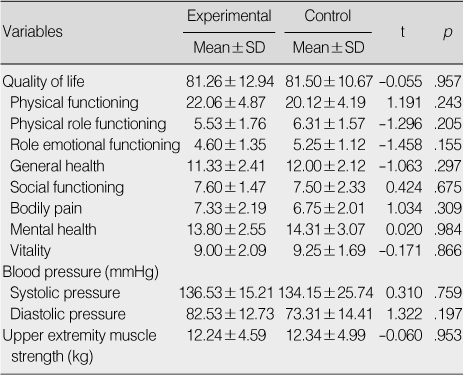
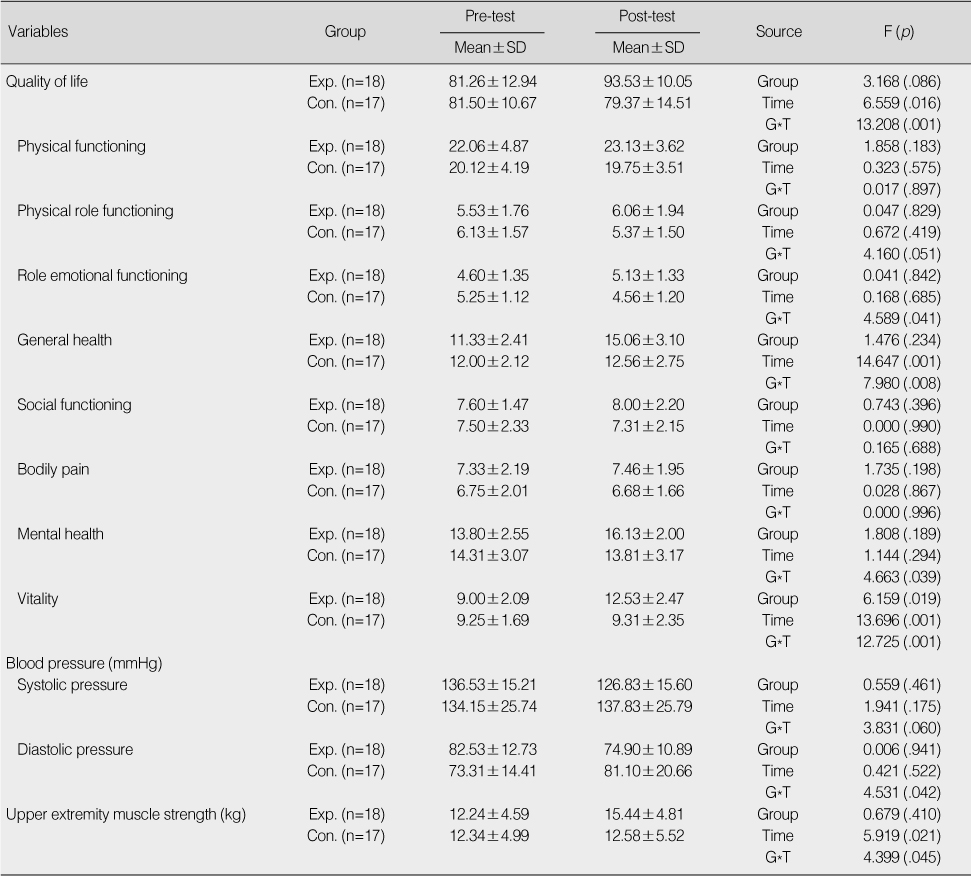
 Cite
Cite

